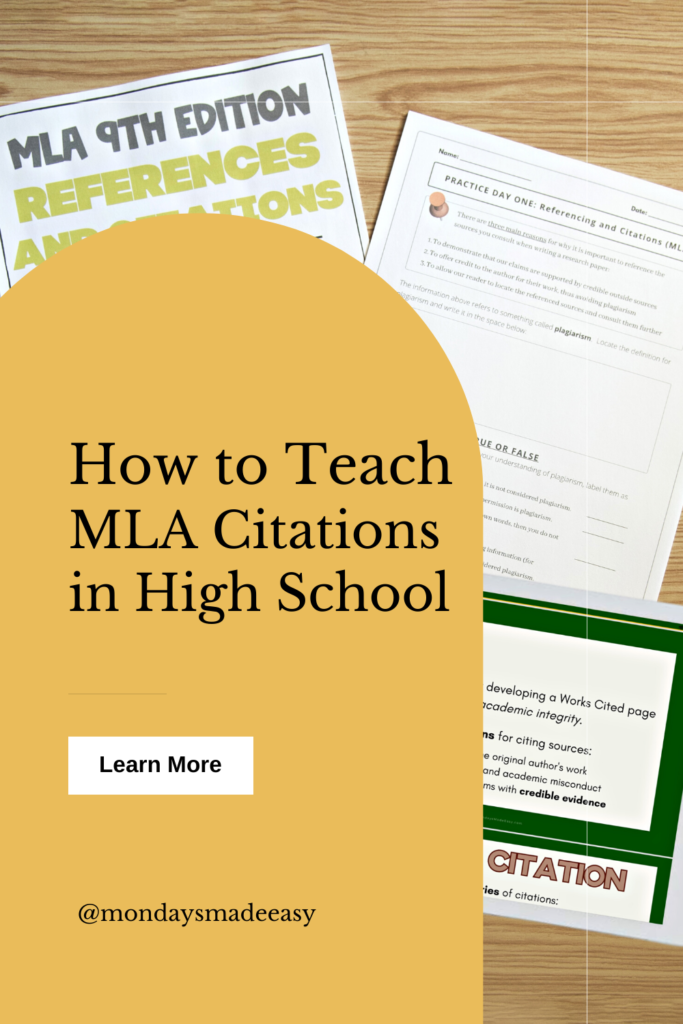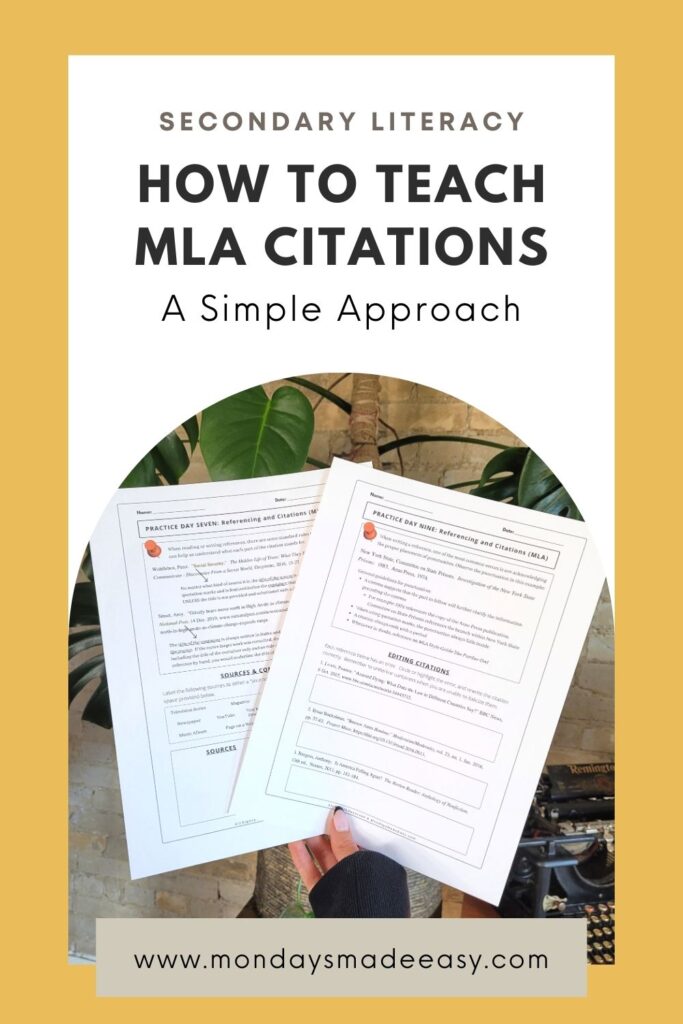
Writing in MLA Format is a challenging task for middle school and high school students. Even with MLA style guides and cheat sheets, it can still feel like learning a new language. When exploring how to teach MLA Format, I’ve learned to actually treat it as if it were a new language. I want my students to become “fluent” so that they can read and write MLA citations effortlessly. In this blog post, I’ll show you an easy and engaging way to teach MLA citations in your classroom.

The Ninth Edition of the MLA Handbook was released in the spring of 2021. Fortunately, MLA 9 is not much different than MLA 8. The MLA Handbook explores more than just how to write citations. It also discusses plagiarism , formatting guides for research writing, guidelines for grammar and mechanics, and recommendations for the use of inclusive language.
The Handbook also has several examples of MLA format. These MLA format examples clarify the changes implemented in the 8th Edition.
For MLA citations specifically, the latest version of the Handbook offers more information about container rules. It explains several different ways to think about containers, especially for online sources. For example, containers can include social media posts like Instagram or Twitter, YouTube channels, forums like Reddit, or online exhibitions.
Another change involves the requirements for URLs. Since URLs are impermanent and not always accessible, they are now optional. Regardless, the Ninth Edition still recommends URLs. When writing in MLA format, students are advised to truncate URLs .
Ultimately, the inclusion of the URL is up to the institution. This means that you can decide how students should approach URLs in their writing. The only exception is that URLs must include the Hypertext Transfer Protocol (https://). This is required for some users to access the webpage.

As mentioned, teaching MLA format is almost like teaching a different language. And much like learning a different language, you can always just use an online translator. However, much like translators, there are drawbacks to relying on MLA citation generators.
For one, relying on a citation generator means students are dependent on this technology. Additionally, citation generators are not always accurate.
When you teach MLA format to students , you can explain these differences to them. Remind students that reading and writing MLA citations is a necessary skill for standardized exams, post-secondary research, and the real world. Taking time to learn how to understand MLA format will be worth their time and effort!
To teach MLA format, you can start with the basics, introduce new concepts slowly, and repeatedly assess comprehension. The key to teaching MLA citations is practice!
To start with the basics, you can pose inquiry-based questions about MLA format . These questions can explore why MLA format is important, and the purpose for which MLA citations are used.
A formative assessment that students respond well to involves true or false questions about plagiarism, citations, and MLA format. This activity measures students’ understanding of why MLA format is important.
To introduce new concepts slowly, I use spiralled instruction to break down information into manageable chunks. For example, one day might focus on identifying different parts of an MLA citation (author, title, date, etc.). The next day can explore why some citations look different than others. The following day might have students identify the type of source in different examples of citations (a book, an article, a YouTube video, etc.).
A key component to spiralled instruction involves revisiting material and assessing comprehension. These MLA citation activities include bite-sized daily tasks and incorporate quiz questions to evaluate students’ understanding of MLA format. They also have students identify common errors in MLA citations.
Eventually, your students will be able to practice writing MLA citations independently. To practice, you can provide students with images of common print and electronic sources . These can include newspaper articles, webpages, and publishing information for books. You can also throw in forms of media that students are engaging with every day – think podcasts, YouTube videos, Instagram posts, and even conversations!

Using an MLA Format “cheat sheet” can help students read and write MLA citations. An MLA format “cheat sheet” should include formatting details about the author, title of source, container, contributor, version, number, publisher, publication date, and location.
You can use the FREE MLA Format Quick Reference Card in my Free Resource Library as a “cheat sheet” for your students. This graphic organizer introduces the core elements of an MLA citation. It also offers indications for formatting each element.
Students can use this “cheat sheet” while writing their works cited pages or while practicing writing MLA citations .

Students often view MLA citations as confusing and see MLA format as overwhelming. This is because MLA citations require a lot of practice. MLA format should be taught and assessed separately from research writing in order to make sure students are comfortable with this skill.
The best way to teach MLA format is through reinforcement. Your students will benefit from starting with the basics and incorporating new concepts slowly. With this approach, students will feel confident with MLA format and will not feel the need to turn to citation generators.
If you’re still looking for advice on how to teach MLA format, check out this MLA citations unit . This bundle includes all of the worksheets, activities, and resources mentioned in this blog post.
To preview the MLA citations unit, click here .